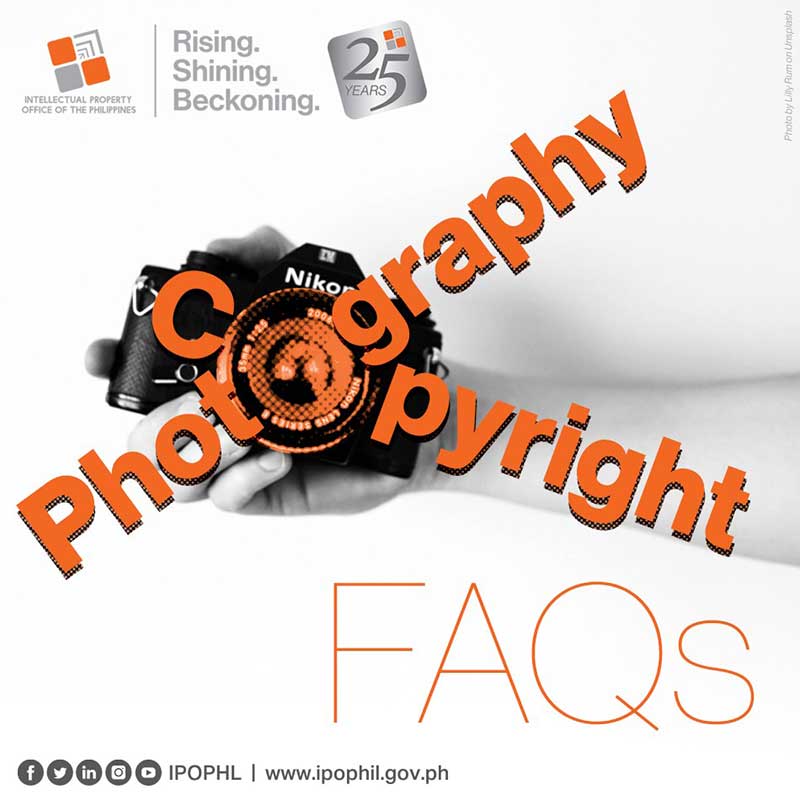
Every year, on August 19, we celebrate world photography day to recognize one of the most important visual media in the world.
The celebration started as a tribute to the invention of the daguerreotype — a process in photography developed by French artist and photographer Louis Daguerre — as it was on August 19, 1839 that the French government bought this invention for the free use of the world.
The Intellectual Property Office of the Philippines (IPOPHL) pays homage to the art and science of taking photos by answering commonly asked questions about photography and copyright with Atty. Exequiel D. Valerio, Attorney IV at the Accreditation and Standards Division of the Bureau of Copyright and Related Rights (BCRR).
- Do I own the copyright to the photos I take?
Generally, yes. But there are exceptions we will explain further in No. 7.
Copyright for each photo lasts 50 years from the date of its publication or from its making if unpublished. During this period, the owner can enjoy the following economic and moral rights to the photo:
Moral rights
- Attribution – the right to be known as the creator of the work.
- Disclosure – the right to make alterations to the work prior to publication, or the right to withhold the work from publication.
- Integrity – the right to object to any distortion, mutilation or other modification of, or other derogatory action in relation to their work which would be prejudicial to their honor or reputation.
- Against false attribution – The right to restrain the use of their name with respect to any work not of their own creation or in a distorted version of their work.
Economic rights
- Reproduction – the right to make one or more copies of a work in any manner or form.
- Adaptation – the right to carry out, authorize or prevent the dramatization, translation, adaptation, abridgement, arrangement or other transformation of the work.
- First public distribution – the right over the first publication of the work.
- Public display – the right of showing a work directly or by means of a film, slide, TV image or other devices.
- Public performance – the right to recitation, playing, dancing, acting or otherwise performing the work, either directly or by means of any device or process.
- Communication to the public – the right to make the work available to the public by wire or wireless means in such a way that members of the public may access these works from a place and time individually chosen by them.
- Should photos be registered first in IPOPHL before they can be protected by the copyright law?
No, registration is not required.
According to the IP Code, copyrightable works are protected by the sole fact of their creation. This means that prior registration with any government agency or private entity is not needed in order for a photograph to obtain copyright protection under the law.
- Are photos required to have the copyright symbols or watermark in order to be protected?
No, copyright symbols or watermarks are also not required.
Since a photo is protected from the moment it is created, the placement of a copyright symbol, or more commonly, a watermark, on the photo vests no additional legal protection. Instead, it merely serves as a means of identifying who took the photograph.
A photo with no copyright symbol or watermark does not necessarily mean that it is already in the public domain.
- As a photographer, can I allow someone else to use my photo without giving up my copyright?
Of course!
This grant of permission is called a license. By means of a license, a copyright owner allows another person to use a photo without giving up their copyright, usually in exchange for the payment of royalties. For example, a photographer can submit their photo for publication in a magazine.
Unless there is an express stipulation stating otherwise, the mere submission of the photo does not mean that the photographer is transferring his or her copyright over to the publisher of the magazine. Rather, it is merely a license for the magazine to make a single publication of the photo, unless a greater right is expressly granted.
- I have been captured in a photograph without my permission. Can I use the copyright law against the photographer?
No, this case is not covered under copyright jurisdiction. A photographer’s subject, while an integral part of the final image, has no part in its creation. The copyright law benefits the creator — the natural person who created the work.
The rights of a person appearing in a photo without his or her authorization pertain to privacy and publicity rights.
A private citizen may invoke their privacy rights if they are captured in a photo without their consent, as long as the subject is readily identifiable in the image.
Meanwhile, in the case of public personalities such as celebrities, the publicity right may be invoked if they wish to prevent the commercial use of the photo where they are a subject, given that such photos have economic value considering their celebrity status.
Thus, it is incorrect for celebrities to say that they deserve a share of the photographer’s royalties whenever a photo containing their image is published since that belief has no basis in copyright law.
- My original photograph has been shared online without my knowledge, but “Credits to the Owner” or “No Copyright Infringement Intended” was used in the caption. Can I still enforce my rights as the photographer?
Yes! Such disclaimers in no way protect the sharers from liability.
Here lies the challenge with social media which encourages the sharing of content practically in real-time. To guide netizens, IPOPHL answered here the most frequently asked questions on sharing and uploading copyrighted works on social media.
To enforce your rights, take advantage of social media platforms’ mechanisms for reporting content and activities that violate laws, including copyright.
IPOPHL also has guidance on the enforcement tools available to IP rights holders on social media giant Facebook.
- An agency hired me to do photography, who owns the copyright to the pictures I take for them?
It depends on the work arrangement.
If it is a commissioned work, you, as the photographer, still own the copyright over the images you create. However, when there is an express stipulation to the contrary in the form of a written agreement, such as when a photographer agrees to transfer his or her copyright to the publisher of the magazine which commissioned him or her.
If you are an employee of the agency, then the copyright to the photos that you create in the course of your employment and according to your regularly-assigned duties belong to the agency. However, if you were hired only on a commission basis, then you still own the copyright to your images, unless otherwise stipulated, while the actual photos themselves are owned by the agency.
- What are the sanctions to those who have been proven to infringe an original photograph?
A person who is found guilty of committing copyright infringement may be penalized with imprisonment from one to nine years plus a fine ranging from P50,000 to P1.5 million, depending on the number of offenses committed. Additionally, the infringing work may be taken down if it was posted online or pulled from the market to prevent its further circulation.
IPOPHL commits to building further awareness about copyright and other related rights to empower more Filipino creatives. For further questions about copyright and other IP information, visit facebook.com/IPOPHL.




















